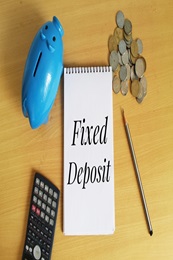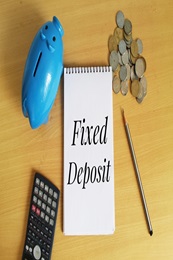The Power of Compounding: How Compound Interest Helps Your FD Grow
April 18, 2025

The Power of Compounding – a phrase commonly used when talking about Fixed Deposits (FDs). However, in India, many investors are still unaware of the benefits of compounding. In fact, the compounding effect is what makes FDs attractive. FD interest is generally calculated either via the simple interest method or compound interest method, depending on the tenure.
For long-term FD investments, generally, banks use the compound interest method to calculate interest. This impacts your FD investment allowing your money grow substantially over time.In this article, we have debunked the concept of compound interest in Fixed Deposits so that you can understand how staying invested for the long-term may help you grow your wealth in a safe and secure way.
The Power of Compounding Simplified
The compound interest calculation method takes into account both the principal amount and accumulated interest from previous periods. Unlike simple interest, where only the principal amount is considered, compound interest allows your money to grow exponentially over time.
Imagine you invest ₹10,000 in a Digital Fixed Deposit with an annual interest rate of 6.9% for 5 years, compounded annually. Using the compound interest formula:
A = P (1 + r/n)^(nt), where A = maturity amount, P = principal amount, r = rate of interest (%), n = the number of times the interest is compounded per year (for FD, it’s usually compounded quarterly, so n= 4 years), t = time in years.
A = 10,000(1 + 0.069/1)^(1*5)
A ≈ 14,078
With compound interest, your initial investment of ₹10,000 has grown to approximately ₹14,078. This growth is due to the power of compound interest, which allows your money to earn interest not only on the principal amount but also on the accumulated interest from previous years.
Disclaimer: The above calculation is for illustration purposes only. Ujjivan SFB doesn’t take responsibility of the accuracy of the information. To check latest Ujjivan FD rates, click here.
Understanding FD Compound Interest Calculation
To understand how compound interest is calculated in FDs, let's break down the formula:
A = P (1 + r/n)^(nt)
Where:
By plugging in the appropriate values, you can calculate the future value of your investment. Most banks provide online calculators that simplify this process for you. However, manual calculations can be taxing and may leave room for errors. To calculate the interest and maturity amount quickly, use our Fixed Deposit ROI Calculator.
Benefits of Compound Interest in FDs
The power of compound interest makes FDs an attractive investment option. Here are some key benefits:
1. Higher Returns and Faster Growth
With compound interest, your money grows faster over time compared to simple interest. That’s because your accumulated interest also earns interest till maturity, contributing to overall growth. This means that you can earn more from your initial investment.
2. Long-Term Wealth Accumulation
The longer you keep your money in FD, the more the compound interest works in your favour. Over longer periods, small initial investments can grow significantly due to compounding.
3. Consistent Growth
FD interest rates remain fixed throughout the tenure ensuring consistent and predictable growth. Compounding enhances this, making the growth steady and reliable.
4. Reinvestment Options
Many banks offer an option to reinvest the maturity amount, where the compounded returns are added back to the principal. This may help investors enjoy higher returns in the long-term.
Simple Interest vs. Compound Interest: Sample Calculation
Let's look at a sample calculation to understand the impact of compound interest on FDs:
Using the compound interest formula:
A = 50,000 (1 + 0.07/1)^(1*5)
A ≈ ₹69,069
Let’s check how your returns would look like using the simple interest method:
Simple Interest calculation formula: (P x R x T)/100 = (50,000 x 0.07 x 5)/100 = 1750000/100 = 17,500.
The interest earned is ₹17,500. The maturity amount would be ₹67,500.
Now, check the difference between the maturity amount, it’s approximately ₹1,500! Now, that’s what you call the power of compounding.
How to Maximise FD Compound Interest
To make the most of compound interest in FDs, consider the following tips:
1. Choose the Right Tenure
Longer tenures generally result in higher earnings from compound interest in fixed deposits. Assess your financial goals and select a tenure that aligns with your needs.
2. Compare Interest Rates
Different banks offer varying interest rates on FDs. To maximise your earnings from FD , compare the interest rates offered by different banks and choose the best option. Generally, small finance banks like Ujjivan SFB offer higher FD rates.
3. Reinvest Earnings
Instead of withdrawing the interest earned, consider reinvesting it into the FD. This strategy will further enhance your earnings, leveraging the power of compounding over time.
4. Automate Investments
Set up automated deposits into your FD account regularly. This ensures consistent contributions and maximises the compounding potential.
Final Thoughts
Understanding compound interest is crucial for making informed financial decisions, especially when it comes to FDs. By harnessing the power of compound interest in fixed deposits, you can grow your savings and achieve your financial goals faster.
Looking to grow your savings? Ujjivan SFB offers a wide range of fixed deposit products. Select the FD of your choice and take a step forward to your financial goals. Alternatively, you can browse through Ujjivan SFB product suite - our wide range of financial products are designed to make your financial life better
April 18, 2025
FAQs
1. How is compound interest calculated in fixed deposits?
Compound interest in fixed deposits is calculated using the formula A = P (1 + r/n)^(nt), where a = maturity amount, p = principal amount, r = rate of interest, n = number of years. The future value of your investment can be determined by plugging in the appropriate values. You can use an online FD ROI Calculator to check the same.
2. What is the difference between simple interest and compound interest?
Simple interest is calculated only on the principal amount, while compound interest takes into account both the principal amount and accumulated interest.
3. What factors influence the amount of compound interest earned in fixed deposits?
The amount earned depends on the principal amount, the interest rate, the frequency of compounding, and the investment tenure.
4. Can I choose the frequency of interest calculation for my FD?
Many banks offer options for compounding interest annually, semi-annually, quarterly, or monthly. It's important to check with your bank to understand the available options and their impact on your earnings.
5. What happens if I withdraw my FD before maturity?
Premature withdrawal of an FD typically results in a penalty and a lower interest rate. The compound interest in fixed deposits will be recalculated based on the revised rate and tenure.
6. How does FD compound interest differ for senior citizens?
Many banks offer higher interest rates for senior citizens on fixed deposits, resulting in higher returns over time.
7. Are there any tax implications on the interest earned from fixed deposits?
Yes, interest earned from fixed deposits is taxable. The interest income is added to your total income and taxed according to your income tax slab. Banks also deduct TDS if the interest earned exceeds threshold of ₹40,000 (for regular citizens) or ₹50,000 (for senior citizens). Please note that this TDS exemption on FD interest is applicable for FY 2024-25 (till March 2025). For FY 2025-26, the TDS exemption limit has been hiked to ₹50,000 for regular citizens and ₹1 lakh for senior citizens.
8. Can I use FD compound interest to plan for my child's education?
Yes, investing in FDs can be a secure way to accumulate funds for your child's education over time.
9. Is it better to invest a large sum in one FD or split it into multiple FDs?
Splitting your investment into multiple FDs can provide flexibility and help manage liquidity needs, while still benefiting from the power of compounding.
10. How does the compounding frequency affect the interest calculation in FDs?
The more frequently the interest is compounded, the higher the total interest earned. For instance, quarterly compounding will result in higher earnings than annual compounding, given the same principal and interest rate.
11. Can I get a loan against my fixed deposit?
Yes, many banks allow you to take a loan against your fixed deposit. The interest on the loan is typically lower than that of a personal loan, but your FD will continue to earn interest.
12. What is the impact of inflation on FD compound interest?
While compound interest helps grow your savings, high inflation can erode the real value of your returns. It's important to compare the FD interest rate with the inflation rate.
13. What are cumulative and non-cumulative fixed deposits?
In cumulative FDs, interest is compounded and paid at maturity, maximising the benefits of compound interest. In non-cumulative FDs, interest is paid out periodically, such as monthly or quarterly, at a discounted rate.
Latest Blogs

Is Closing Your Home Loan Early Good or Bad for Your Credit Score?
April 15, 2025
In the world of personal finance, owning a home is often seen as the pinnacle of financial stability.

Telangana Housing Board & KPHB Colony: A Guide to Affordable Urban Housing in Hyderabad
March 14, 2025
As Telangana continues its rapid urbanisation journey, two key housing entities—Telangana Housing Board (THB) and Kukatpally Housing Board Colony (KPHB)—have played critical roles in shaping the state's real estate ecosystem.

Does Checking CIBIL Score Frequently Lower Your Credit Points?
April 07, 2025
Imagine you're planning to apply for a home loan, a credit card, or even a car loan. Naturally, you want to ensure your CIBIL score is in good shape before proceeding.

7 Steps to Get Started Your Home Loan Application Process in India
April 16, 2025
Buying a home is one of the biggest dreams for most of us. But with rising property prices, it's not always possible to pay the full amount upfront. That’s where a home loan in India becomes a helpful option.

How to Keep Your Money Growing in a Volatile Market: A Comprehensive Guide
April 15, 2025
The Indian financial landscape in early 2025 has been quite unpredictable. According to Reuters, equity mutual fund inflows slumped to an 11-month low in March 2025 due to growing concerns around sectoral imbalances and global uncertainties.

Is Closing Your Home Loan Early Good or Bad for Your Credit Score?
April 15, 2025
In the world of personal finance, owning a home is often seen as the pinnacle of financial stability.

Telangana Housing Board & KPHB Colony: A Guide to Affordable Urban Housing in Hyderabad
March 14, 2025
As Telangana continues its rapid urbanisation journey, two key housing entities—Telangana Housing Board (THB) and Kukatpally Housing Board Colony (KPHB)—have played critical roles in shaping the state's real estate ecosystem.

Does Checking CIBIL Score Frequently Lower Your Credit Points?
April 07, 2025
Imagine you're planning to apply for a home loan, a credit card, or even a car loan. Naturally, you want to ensure your CIBIL score is in good shape before proceeding.

7 Steps to Get Started Your Home Loan Application Process in India
April 16, 2025
Buying a home is one of the biggest dreams for most of us. But with rising property prices, it's not always possible to pay the full amount upfront. That’s where a home loan in India becomes a helpful option.

How to Keep Your Money Growing in a Volatile Market: A Comprehensive Guide
April 15, 2025
The Indian financial landscape in early 2025 has been quite unpredictable. According to Reuters, equity mutual fund inflows slumped to an 11-month low in March 2025 due to growing concerns around sectoral imbalances and global uncertainties.

Is Closing Your Home Loan Early Good or Bad for Your Credit Score?
April 15, 2025
In the world of personal finance, owning a home is often seen as the pinnacle of financial stability.





